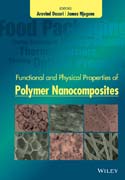
Functional and Physical Properties of Polymer Nanocomposites
Dasari, Aravind
Njuguna, James
The first book to extensively cover nanoparticles, this addresses some of the key issues in nanocomposites. Polymer nanocomposites (polymers reinforced with nanoparticles), are of great interest due to their remarkable mechanical, thermal, chemical properties as well as optical, electronic, and magnetic applications Potential applications include automobile body parts, high–barrier packaging materials, flame–retardants, scratch–resistant composites, and biodegradable nanocomposites Combines basic theory as well as advanced and in–depth knowledge of these properties Broad audience includes researchers in Materials Science, Physics, Polymer Chemistry, and Engineering, and those in industry INDICE: Chapter 1 Introduction .Chapter 2 3D microstructural characterization of polymer nanocomposites by electron tomography Florent Dalmas and Lucian Roiban .2.1 Introduction .2.2 3D observation at the nanoscale .2.2.1 Imaging with electrons .2.2.2 Principles of transmission electron tomography .2.3 Application to polymer matrix nanocomposites .2.4 3D image analysis and quantification .2.5 Conclusion and prospects .References .Chapter 3 Polymer Nanocomposites for Food Packaging Applications Shiv Shankar and Jong–Whan Rhim .3.1 Introduction .3.2 Polymer Nanocomposites .3.2.1 Types of polymer .3.2.2 Types of nanofillers .3.2.2.1 Organic nanofillers .3.2.2.2 Inorganic nanofillers .3.3 Preparation of nanocomposite .3.4 Characterization of polymer nanocomposites .3.5 Types of polymer nanocomposite packaging .3.5.1 Rigid packaging .3.5.2 Nylon based packaging materials .3.5.3 Biodegradable packaging .3.5.4 Flexible packaging .3.5.5 Active packaging .3.5.6 Intelligent/smart packaging .3.5.7 Nanocoating .3.5.8 Edible coating/packaging films .3.5.9 Other types of packaging .3.6 Properties of Polymer Nanocomposites .3.6.1 Mechanical properties .3.6.2 Barrier properties .3.6.3 Chemical resistance properties .3.6.4 Biodegradation properties .3.6.5 Other properties .3.7 Conclusions .References .Chapter 4 Functional and physical properties of polymer nanocomposites Nanocomposites biodegradation Kikku Fukushima and Giovanni Camino .4.1 Introduction .4.2 Biodegradation of polymers and their nanocomposites .4.2.1 Standards for environmentally biodegradable polymers .4.2.2 Mechanisms of polymer biodegradation .4.2.2.1 Polymer chain scission .4.2.2.2 Degradation site .4.2.2.3 Degradation via hydrolysis .4.2.2.4 Various degradation mechanisms .4.3 Biodegradation of polymers from natural resources and their nanocomposites .4.3.1 Polysaccharides .4.3.1.1 Starch .4.3.1.2 Cellulose and chitosan .4.3.2 Proteins .4.3.2.1 Gelatine .4.3.2.1 Wheat gluten .4.3.3 Polyesters .4.3.3.1 Polyesters produced by micro–organism or by plants .4.3.3.2 Polyesters synthesized from bio–derived monomers and their nanocomposites .4.4 Biodegradation of polymers from fossil origins and their nanocomposites .4.4.1 Aliphatic polyesters from fossil origins .4.4.1.1 Polybutylene succinate (PBS) .4.4.1.2 Polycaprolactone (PCL) .4.4.2 Aromatic polyesters from fossil origins .4.4.2.1 Polybutylene adipate–co–terephthalate (PBAT) .4.4.3 Polyvinylalcohols (PVA) .4.4.4 Polyurethanes (PU) .4.5 Summary .References .Chapter 5 Functional Fibers Produced Using Electrospinning Techniques for Energy Scavenging Applications Avinash Baji and Yiu–Wing Mai .5.1 Introduction .5.2 Principle of Electrospinning .5.3 Fabrication of Aligned Fibers .5.4 Fabrication of Ferro/Piezoelectric Organic Fibers .5.5 Fabrication of Ferro/Piezoelectric Inorganic Fibers .5.6 Fabrication of Fibers Filled with Reinforcements .5.7 Characterization of Ferro/Piezoelectric Behavior of Electrospun Fibers .5.8 Piezoresponse of Electrospun Fibers .5.9 Nanogenerators Based on Electrospun Fibers .5.10 Energy Harvesters Based on Electrospun Fibers .5.11 Force/Pressure Sensors .5.12 Multifunctional Inorganic Fibers .5.13 Magnetoelectric Inorganic Fibers .5.14 Future Directions .5.15 Acknowledgement .References .Chapter 6 Magnetic properties of polymer nanocomposites Paolo Allia, Marco Sangermano and Alessandro Chiolerio .6.1 Introduction .6.2 Preparation of magnetic NPs and its influence on the properties of NCs .6.2.1 Top–down versus bottom–up approach to synthesis .6.2.2 Considerations regarding homogeneity and interactions .6.3 Anhysteretic properties and interparticle interactions .6.4 Hysteretic properties .6.5 Applications .References .Chapter 7 Optical properties of polymer nanocomposites Ignazio Roppolo, Marco Sangermano and Alessandro Chiolerio .7.1 Introduction .7.2 Photoluminescence and related applications .7.2.1 Luminescence from direct photoexcitation of the emitting species .7.2.1.1 Nancomposite with quantum dots .7.2.1.2 Transition metals nanocomposites .7.2.1.3 Rare earth polymer nanocomposites .7.3 Light Emission in polymer nanocomposites: from science to applications .7.4 Transparency and adsorbance in polymer nanocomposite .References .Chapter 8 Bismuth based nanomaterials and platforms for sensing and biosensing applications Miquel Cadevall, Josep Ros and Arben Merkoçi .8.1 General properties and applications of bismuth .8.2 Bismuth nanoparticles synthesis .8.2.1 Chemical methods .8.2.2 Physical methods .8.3 Bismuth based modifications and composites for (bio)sensing platforms .8.3.1 Chemical sensing .8.3.2 Biosensig applications .8.4 Conclusions .References .Chapter 9 High Temperature Resistant Polymer Nanocomposites Indraneel S Zope and Aravind Dasari .9.1 Background .9.2 Representative high performance polymer nanocomposites .9.2.1 Polyethersulfone nanocomposites .9.2.2 Polyimide nanocomposites .9.2.3 Polyetherimide nanocomposites .9.3 Applications of high temperature polymers and their nanocomposites .9.4 Acknowledgements .References
- ISBN: 978-1-118-54232-3
- Editorial: Wiley–Blackwell
- Encuadernacion: Cartoné
- Páginas: 216
- Fecha Publicación: 03/06/2016
- Nº Volúmenes: 1
- Idioma: Inglés
